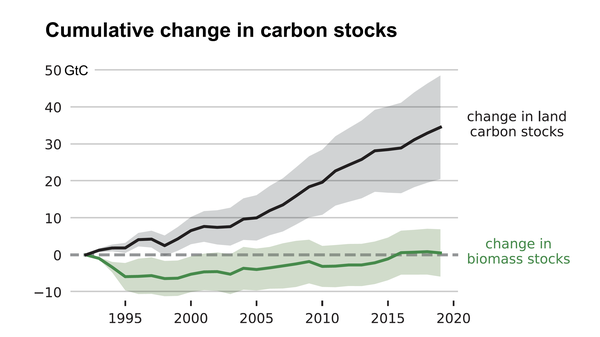Over the past three decades, most of the carbon absorbed by land has been stored in non-living reservoirs such as soil, dead wood and sediments, rather than in the world’s forests. This surprising finding comes from research carried out as part of the European Space Agency's (ESA) Climate Change Initiative (CCI) “REgional Carbon Cycle Assessment and Processes” (RECCAP-2) project, which found that land absorbed around 35 gigatonnes of carbon between 1992 and 2019, with only 6% of this stored in living vegetation such as trees.
"While living biomass is critical for biodiversity and ecosystem services, our findings show that non-living carbon pools are the unsung heroes of carbon sequestration," says Yinon Bar-On, postdoctoral researcher at the Division of Geological and Planetary Sciences, California Institute of Technology, and lead author of the study. "These reservoirs play a much larger role in mitigating climate change than we previously understood, and many of them are intimately linked to human activities such as wood harvest or river damming."
Strengthening scientific understanding of the carbon cycle and its fluxes is the focus of ESA's Climate Change Initiative (CCI) and the RECCAP-2 project. Using satellite observations as one input, researchers can more accurately quantifying where and how carbon is stored and improve the models used to predict future changes in the carbon cycle and their impact on the climate.
Remote sensing reveals dominance of non-living carbon pools in global storage

To analyse changes in terrestrial carbon storage, the research team combined inventory-based estimates with remote sensing technologies, using data from country and regional biomass inventories as well as global satellite observations. These datasets varied in spatial resolution, time period, and type of biomass measured (e.g. above-ground vs. total biomass). To ensure consistency, the team harmonised the data by aligning it with the ten pre-defined key global regions and standardising measurements over different time intervals. This process allowed them to construct a unified, global picture of carbon storage dynamics over the past three decades.
Their analysis shows that annual carbon accumulation rates have increased significantly, rising by 240%, from 0.5 gigatonnes in the 1990s to 1.7 gigatonnes in the 2010s. Non-living reservoirs accounted for the majority of the carbon stored during this period, far outweighing the contribution of living biomass like trees. These findings challenge the long-held belief that forests are the dominant carbon sinks and highlight the resilience and critical role of non-living carbon pools in mitigating climate change.
“The results of this study provide a new perspective for the ESA RECCAP-2 project. Improving our understanding of where carbon is stored makes a huge difference in how we assess carbon dynamics. Our research has the potential contributing to a better assessment of the collective progress made towards achieving the purpose of the UNFCCC Paris Agreement to combat climate change,” states Clement Albergel, head of ESA’s Actionable Climate Information section.
Regional trends highlight global disparities
Russia, North America, East Asia and Europe have seen the largest increases in carbon stocks, driven by afforestation and forest regrowth. However, while forests initially store carbon in living biomass, much of it is transferred to non-living reservoirs where it remains more stable over time. This explains why most of the carbon stored in these regions is in non-living pools rather than in trees or other vegetation.
In contrast, South America and Africa experienced declines in live biomass due to deforestation and land-use change, contradicting the predictions of Dynamic Global Vegetation Models (DGVMs) which are used by the scientific community to simulate dynamics of ecosystem processes such as the carbon cycle. These models however appear to underestimate the impact of forest degradation and disturbance such as fires and droughts in tropical regions, and based on the new study, also fail to account for significant carbon storage in non-living pools in northern regions.
Re-evaluation of dynamic global vegetation models
The research calls for a re-evaluation of dynamic global vegetation models (DGVMs), which currently overestimate the role of forests in carbon sequestration. While forests remain vital for biodiversity and ecosystem services, the study highlights the important contribution of these non-living carbon sinks to the carbon cycle and the need to recognise and protect them, many of which are affected by human activities such as dams, reservoirs and timber harvesting.
Improving future climate modelling
By integrating non-living carbon pools into climate change strategies, policymakers can improve the management of carbon stocks by focusing on practices such as improving soil health, protecting wetlands and preventing sediment loss. These actions not only increase carbon sequestration but also help to mitigate the effects of global warming and support long-term ecosystem resilience. As a result, the study highlights the potential for more sustainable carbon management practices that harness the durability of non-living reservoirs to slow global warming.
Reference: Yinon M. Bar-On et al, Science, DOI: 10.1126/science.adk1637.
Find out more about RECCAP-2 Climate Space project: RECCAP-2 Climate Space project

